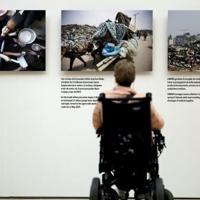Major Madrid Museum Launches Exhibition Featuring Gaza Photographs


On Tuesday, the Thyssen-Bornemisza Museum in Madrid unveiled a poignant exhibition titled “Gaza Through Their Eyes,” showcasing the harrowing experiences of individuals living amid the devastation in Gaza. This exhibition, featuring photographs by acclaimed photojournalists, seeks to incite a deeper awareness and understanding of the humanitarian crisis currently unfolding in the Palestinian territory.
The exhibition’s timing is particularly significant, as Spain has long been a vocal advocate for Palestine and has actively participated in international efforts to raise awareness of humanitarian issues in the region. Against this backdrop, “Gaza Through Their Eyes” aims not only to inform but also to stir the “sleeping consciences” of its audience, prompting critical discussions about the ongoing violence and suffering experienced by civilians in Gaza.
Visitors to the exhibition will encounter a series of evocative images that capture the stark realities of life in Gaza. Photographs depict residents receiving vital humanitarian aid, emphasizing the dire need for assistance amidst widespread destruction. Other images illustrate the resilience of local children who, amidst the ruins, engage in makeshift education systems, reflecting a community’s determination to continue despite challenging circumstances. Through these visual narratives, the exhibition offers an unfiltered glimpse into the daily lives of families grappling with the trauma of conflict and displacement.
In an era marked by rapid information dissemination via social media and digital platforms, the power of photography remains profound, serving as an important vehicle for humanizing complex geopolitical issues. The exhibition seeks to bridge the gap between statistics and human stories, engendering empathy among viewers and fostering a sense of responsibility toward those affected by the ongoing conflict.
The “Gaza Through Their Eyes” exhibition at the Thyssen-Bornemisza Museum is emblematic of the role that cultural institutions can play in shaping public discourse around pressing social issues. By presenting art that confronts the grim realities of life in conflict zones, institutions can ignite conversations that resonate beyond the museum walls, potentially influencing public opinion and policy toward humanitarian crises.
In conclusion, as this exhibition opens its doors to the public, it invites a deeper exploration of the personal stories entwined within the broader narrative of Gaza, emphasizing the urgency of humanitarian advocacy in today’s interconnected world.






